#salmon and sturgeon fishing it is
Text
I'm once again asking to take Wrecker fishing.
#the bad batch#star wars#tbb wrecker#wrecker my beloved#he would probably sink the kayaks we use for bass fishing but thats okay#i dont mind#so i guess we take the boat instead🤷♀️#salmon and sturgeon fishing it is#the boat got more room for activities anyway 👀
21 notes
·
View notes
Text
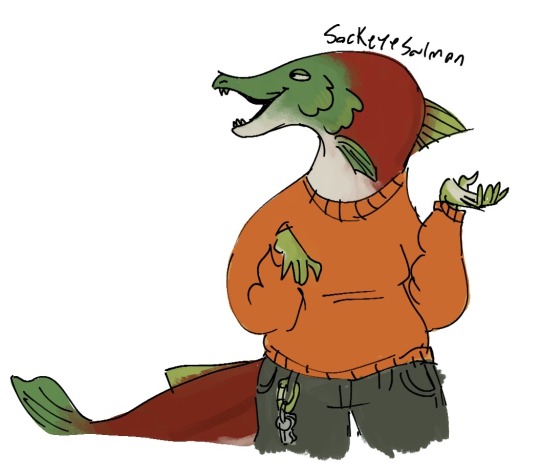
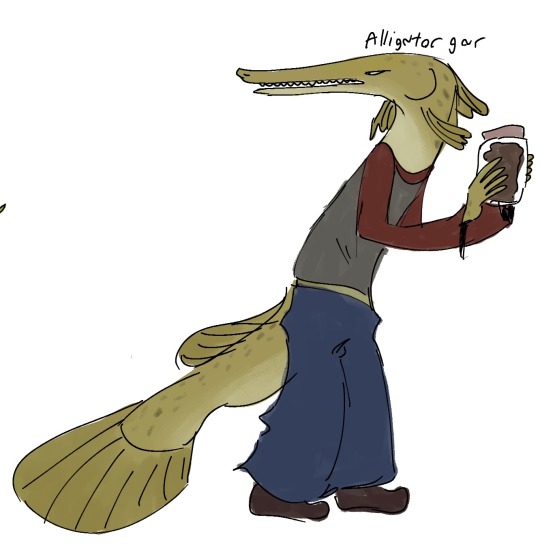



fishies
#ignore that they’re all basically doing the same pose#fish#freshwater#my art#furry#lesbian#lamprey#salmon#gar#trout#sturgeon#scaly#fursona#doodle#art
18K notes
·
View notes
Text
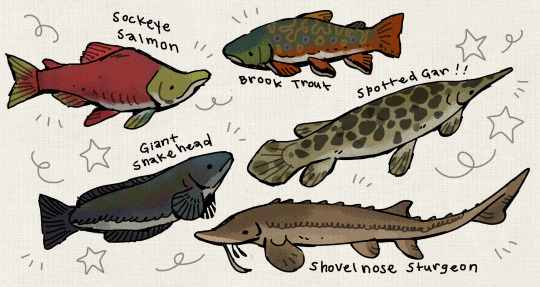

fish requests #1 :-D
#sockeye salmon#brook trout#spotted gar#giant snakehead#shovelnose sturgeon#nature art#queer#trans#digitial art#my art#ty to everyone who sent fish reqs im excited to get through em#maybe some more stamps soon too :-0
13K notes
·
View notes
Text

fish want me, women fear me
#goosey rambles#fish#hiiii#so salmon salmonella isn't new but#Shaun S. Murphey and The Rainbow Trout are. smiles#the s stands for Sturgeon btw#anyways. good Christmas#ignore my lack of sheets rn they are just getting cleaned but#::]#salmon salmonella tag#shaun s. murphey tag#trombone trout tag
661 notes
·
View notes
Text
Recently extinct species make me sad for all the usual and normal reasons (loss of life, biodiversity and unique life forms that experienced the world wholly uniquely and acted in it like no other, to name three), but a big thing that also makes me so sad is the forgetting that comes right after. Many endangered species are greatly ignored to begin with whilst alive of course, which is awful, but the way that extinction also causes us to forget. A species could’ve been so abundant a hundred years ago, people would’ve used a fish species or a tasty plant for food, or parents would’ve warned their children to not put a poisonous toadstool or insect in their mouth, a diver would exclaim, “Aha!” after emerging from the shallows holding an especially big bivalve, or someone making a species diary would sketch out a local bird or fasten a single flower to the page. But.. then the species goes extinct. It doesn’t exist anymore. None of these events, these actions happen anymore. Not with these species. The people who had these experiences dwindle out and they may not even realise that their experiences were among the last of their kind. And we forget.
#i was thinking about the new zealand greyling which was once abundant#the maori people used to fish it and use it for food#for generations upon generations this fish species was their normal#but now it is just gone#could they have guessed that this will happen? that their everyday food item would go extinct one day#i was also thinking about the atlantic sturgeon and how it went regionally extinct in the baltic#the old northern europe people knew sturgeons. heck we had them less than a hundred years ago still#it was a native fish just like any other. just like salmon and trout#now? no one talks about them#they are forgotten#we dont learn about them alongside the perch and the pike and the roach and the trout#they are a mystery of a time gone by here#and it makes me so sad… how quickly we forget. we shouldnt
185 notes
·
View notes
Text
fish blog fish blog fish blog
#fish#bears#salmon#sloth bear#plane#airplane#train#boat#steam engine#what are other things I'll be posting here#oh!#sturddlefish#sturdlefish#sturgeon#chinook salmon#tuna
5 notes
·
View notes
Photo

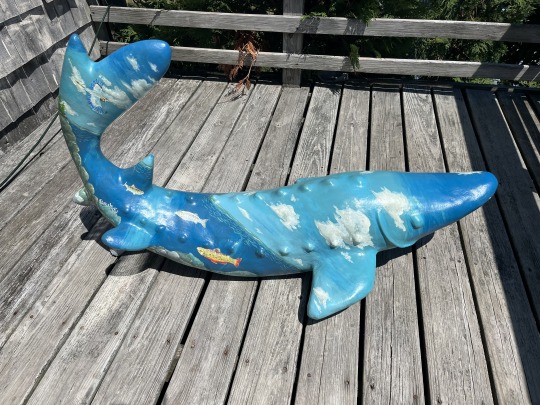
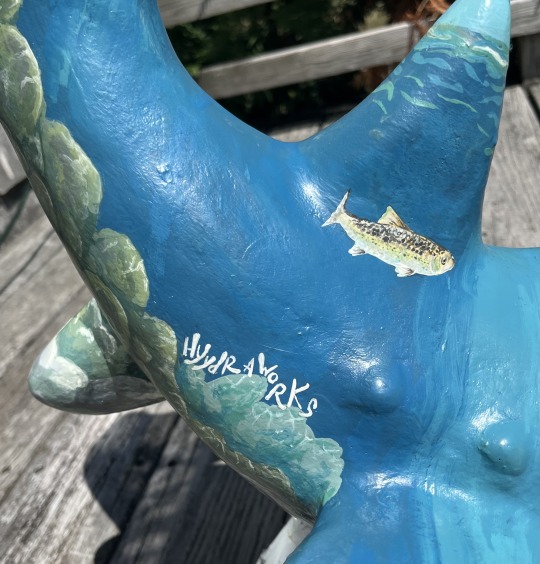
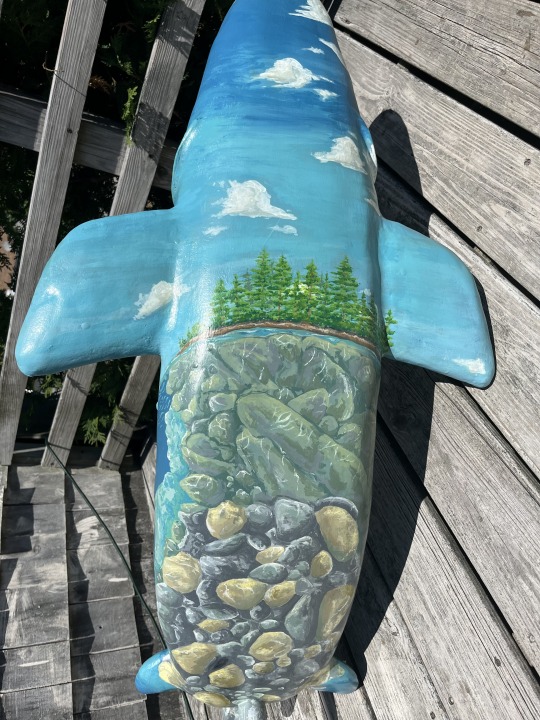

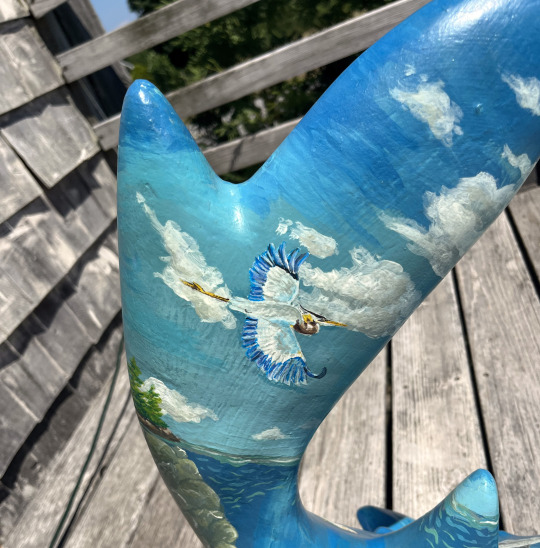

Bit of a photo dump of Margaret, who got installed along with 24 other gorgeous Sturgeons in downtown Augusta, Maine last Saturday. I know a lot of folks that follow me here are anything but local, but they will be up for 2 years so if you ever happen by, many feesh await.
#hyydraworks#maine#landscape#margaret the sturgeon#sturgeon#fish#augusta maine#painting#illustration#3d art#atlantic salmon#blue heron#rainbow smelt#striped bass#native maine fish#pine trees
173 notes
·
View notes
Text

“Sturgeon in the River” is a painting of a white sturgeon swimming underwater in the Fraser River, British Columbia. Other fish featured are a rainbow trout and a Chum salmon; this piece also features small parts of sparkly paint on the fish and bubbles
#sturgeon fish#animal art#painting#rainbow trout#salmon#bubbles#drawing#my art#river#British Columbia#canada#sparkly#rocks#cute animals#illustration
3 notes
·
View notes
Text
Today I want to talk about the Pacific Northwest Tree Octopus (Octopus paxarbolis).
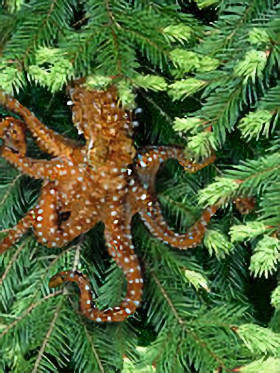
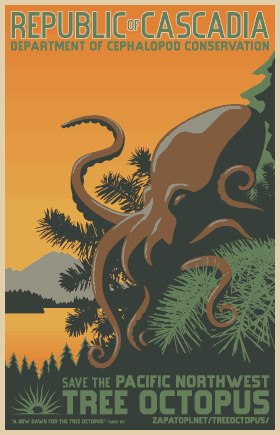
OK, so for those who don't know, the PNW Tree Octopus was an internet hoax created in 1998 consisting of a website detailing the animal's life history and conservation efforts. It's completely fake - saying that up front. This animal never existed.
But if you look at this from a speculative biology standpoint? It's genius.
There is one, and only one, thing preventing Octopus from colonizing and being hugely successful in terrestrial environments in the PNW, and that's the fact that no cephalopod has ever been able to overcome the osmotic stress of inhabiting freshwater. We don't know why this is; other mollusks evolved freshwater forms just fine. But if you hand-wave away that one, single limiting factor, the PNW is just primed for a terrestrial octopus invasion.
The Pacific coast of North America is an active tectonic boundary, meaning the coast transitions pretty much immediately into the Cascade and Coastal mountain ranges (contrast with the east coast and its broad Atlantic plain). It's also a lush temperate rainforest, with very high precipitation. This means lots and lots of high-gradient mountain streams with lots of waterfalls and rapids and cold, highly oxygenated water, and not as many large, meandering rivers.
This has important consequences on the freshwater fauna. For one, there are not many freshwater fish in the Pacific Northwest - the rapids and waterfalls are extremely hard to traverse, so many mountain streams are fish-free. There also just isn't much fish diversity in the first place - there's sturgeon in the big rivers, salmonids, a few sculpin and cyprinids and... that's pretty much it. These cold northern rivers are positively impoverished compared to the thriving fish communities of the Mississippi or Rio Grande.
Few fish means few predators, and depending on the size of the first freshwater octopus, salmon and trout just wouldn't be much of a threat. And while these rivers don't have much in the way of fish diversity, there's lots of prey available - crayfish, leeches, mosquito larvae, frogs and tadpoles, water striders, and other aquatic insects, just to name a few. So the first Octopus pioneers to invade the rivers would be entering what essentially amounts to a predator-free environment with lots and lots of food and no competition. Great for colonization.
These ideal conditions get even better once you get up past the rapids and waterfalls, since there's no fish whatsoever in those streams. Octopus, with their sucker-lined arms, are perfectly equipped to navigate fast-moving, rocky-bedded streams and climb up cliffs. They'd also be well able to traverse short stretches of dry ground to access even more isolated pools and ponds. In fact, once Octopus overcome the osmoregulation problem there's nothing at all preventing them from colonizing land in earnest, since the PNW rainforests are so wet; there's no danger of drying out.
Finally there's the question of reproduction. Octopus are famously attentive mothers, because they need to keep the water around their eggs moving and well-oxygenated. In a mountain stream, this wouldn't be an issue, because the cold, turbulent water holds lots and lots of oxygen. Breeding in high mountain streams would be ideal, and the mothers might not even need to attend to their eggs, freeing them up to evolve away from semelparity and allowing them to reproduce more than once in their lives; their populations would thus increase rapidly and dramatically.
I think, if octopus managed to invade freshwater ecosystems in the PNW, it would dramatically change the ecology much like an invasive species. They'd be unstoppable predators of frogs, bugs, slugs, maybe even larger animals like snakes, birds, and small mammals. Nothing would eat them except maybe herons, and things like bears and raccoons would give them a wide berth due to their venom. They would rule that landscape.
The tl;dr is that the PNW is primed for invasion by cephalopods, if only they could manage to overcome the osmoregulation problem and live in freshwater. If the Pacific Northwest Tree Octopus really did exist, it wouldn't be a shy and reclusive species on the brink of extinction; it would be a pest, an invasive, overpopulated menace you couldn't get rid of if you wanted to. I can just imagine them crawling up onto people's bird feeders and either stealing the nuts or luring in unsuspecting sparrows and starlings. They would sit in the trees and throw pinecones at hikers for fun. They would be some unholy mixture of snake and slug with the personality of a magpie and I am incensed that they only exist in fiction.
#long post#octopus#speculative biology#speculative evolution#spec bio#spec evo#pacific northwest#pacific northwest tree octopus#truly a shame that there are no freshwater or terrestrial cephalopods
294 notes
·
View notes
Text
Here in the Pacific Northwest, the iconic fish that we most commonly associate with the ecological devastation of dams is the salmon. However, sturgeons also face extinction due in part to these massive structures that not only change the flow and temperature of rivers, but can cut fish off from their breeding grounds. That includes in my home state of Missouri.
Sturgeons are really incredible animals. Their unique lineage split off from the rest of the fish during the early Jurassic, 175 to 200 million years ago. Sturgeons themselves can be comparatively ancient, with some individuals living 150 years. They may not breed until they are at least 25 years old.
Lake sturgeons (Acipenser fulvescens) are one of many species driven close to extinction by overfishing for meat and roe, as well as habitat loss and pollution. For the past three decades biologists have been reintroducing this species to parts of its historic range in Missouri, and for the third time since conservation efforts began they have witnessed these fish--now grown up--spawning. Previous observations were made in 2015 and 2022, meaning the recovery is still quite recent.
But it's proof positive that restoring habitat, once again, is one of the best ways we can help wildlife. Long may the sturgeon swim!
#fish#sturgeon#wildlife#nature#animals#habitat restoration#endangered species#extinction#conservation#environment#environmentalism#ecology#restoration ecology#good news#hopepunk#Missouri#science#scicomm#science communication#fishing
508 notes
·
View notes
Text
The Hanford nuclear site was established in 1943 as part of the Manhattan Project, and over the next four decades produced nearly two-thirds of the plutonium for the US’s nuclear weapons supply, including the bomb dropped on Nagasaki.
During its lifespan, hundreds of billions of gallons of liquid waste were dumped in underground storage tanks or simply straight into the ground. After the site’s nine nuclear reactors were shut down by 1987, about 56m gallons of radioactive waste were left behind in 177 large underground tanks – two of which are currently leaking – alongside a deeply scarred landscape.
In the decades since, the Yakama Nation has been one of four local Indigenous communities dedicated to the cleanup of this historic landscape. For the Yakama Nation, that has meant tireless environmental and cultural oversight, advocacy and outreach with the hope that one day the site will be restored to its natural state, opening the doors to a long-awaited, unencumbered homecoming.
Today, their outreach work has reached a fever pitch. There are few Yakama Nation elders still alive who remember the area before its transformation, and there are likely decades to go before cleanup is complete. So members are racing to pass on the site’s history to the next generation, in the hopes they can one day take over.
Yakama Nation history on the Hanford site dates back to pre-colonization, when people would spend the winter here fishing for sturgeon, salmon and lamprey in the Columbia River, as well as gathering and trading with other families. In 1855, the Nation ceded over 11m acres of land to the US, which included the Hanford area, and signed a treaty that relegated them to a reservation while allowing the right to continue fishing, hunting, and gathering roots and berries at “all usual and accustomed places”.
But in the 1940’s, the situation shifted dramatically when the area was cleared out to make room for the construction of nuclear reactors.
LaRena Sohappy, 83, vice-chairwoman for Yakama Nation General Council, whose father was a well-known medicine man, grew up in Wapato, about 40 miles from Hanford. She said she remembers the strawberry fields that lined the Hanford site, her family gathering Skolkol, a root and daily food, and traveling to the area for ceremonies.
Her cousin’s family who lived close to Hanford were woken in the middle of the night and forced to leave to make way for the nuclear site, she recalled
“They didn’t have time to pack up anything,” said Sohappy. “They just had to leave and they were never told why and how long they were going to be gone.”
The effort to give Indigenous people a voice in Hanford’s fate was forged in part by Russell Jim, a member of Yakama Nation’s council, whose work has been credited with helping to keep Hanford from becoming a permanent “deep geologic repository”, a place where high-level nuclear waste from this site and others across the country would be stored.
“From time immemorial we have known a special relationship with Mother Earth,” Jim, who died in 2018, said in a statement to the US Senate in 1980. “We have a religious and moral duty to help protect Mother Earth from acts which may be a detriment to generations of all mankind.”
Today, the ER/WM program, which was founded in the early 1980’s with Jim at the helm, includes such staff as a biologist, ecologist and archeologist. It’s funded by the US Department of Energy (DoE), which operates the Hanford site and leads the cleanup process under an agreement with the US Environmental Protection Agency (EPA) and the Washington state department of ecology.
The Yakama Nation program’s focus is on accelerating a thorough cleanup of the site, protecting culturally significant resources and assessing the threats to wildlife and water.
1K notes
·
View notes
Text
I love you frilled sharks I love you goblin sharks I love you viper dogfish I love you Greenland sharks I love you Cookie cutter sharks I love you crocodile sharks I love you winghead sharks I love you angular roughsharks I love you whitetip reef shark I love you epaulette shark I love you deep sea dragon fish I love you barrel eye I love you viper fish I love you frog fish I love you tripod fish I love you angler fish I love you hatchet fish I love you fangstooth I love you lantern fish I love you deep sea giant isopods I love you vampire squid I love you glass squid I love you blobfish I love you chimeara I love you hagfish I love you deep sea lizard fish I love you snaggletooth eel I love you lancet fish I love you sturgeon I love you moray eel I love you worm goby I love you lemon shark I love you great white shark I love you mako shark I love you thresher shark I love you salmon shark I love you deep sea skate I love you megamouth shark I love you sixgill shark I love you sleeper shark Iove you bigfin squid I love you white spot jellyfish I love you firework jelly fish I love you telescope fish I love you gulper eel I love you snipet eel I love you oarfish I love you sea butterfly I love you firefly squid I love you ceolocanth I love you crocodile snake eel I love you crocodile fish I love you sea Angel I love you alligator gar I love you wels catfish I love you arapaima I love you piranha I love you koi fish daggernose sharks I love you threadfin snailfish I love you bony earred ass fish I love you sea robin I love you plecos I love you sawfish I love you sawshark I love you leopard shark I love you zebra shark I love you wobbegong shark I love you angel shark I love you sand tiger shark I love you deep sea batfish I love you bamboo sharks I love you rattail fish I love you nautilus I love you squid worm I love you fish creatures all very very much
#theres more butbshshd#autism posting#fish#sharks#deep sea life#i love fish so so so so much they're so fucking cool#deep sea fish gotta be one of my favorite genders#reptile appreciation coming soon
367 notes
·
View notes
Text
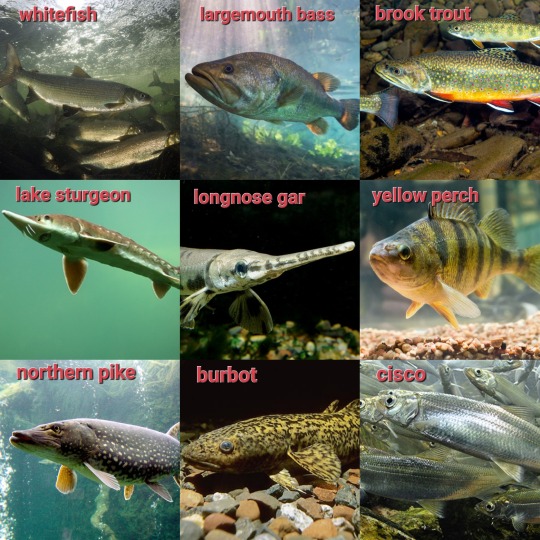
Please add other Great Lakes fish I have missed in the tags if they're you're favorite 🐟🩵 also note these are fishes native to the Great Lakes which is why no salmon
#fish#fishposting#great lakes#lakeposting#lake#midwest#poll#ecology#animals#wildlife#naturecore#nature#freshwater#freshwater ecology#biology#aquatic ecology#me#mine#water
211 notes
·
View notes
Text
"At least 239 barriers, including dams and weirs, were removed across 17 countries in Europe in 2021, in a record-breaking year for dam removals across the continent.
Spain led the way, with 108 structures taken out of the country’s rivers. “Our efforts to expand dam removals across Europe are gathering speed,” said Pao Fernández Garrido, project manager for the World Fish Migration Foundation, who helped produce Dam Removal Europe’s annual report.
“An increasing number of governments, NGOs, companies and communities are understanding the importance of halting and reversing nature loss, and buying into the fact that dam removal is a river-restoration tool that boosts biodiversity and enhances climate resilience. We’re also seeing lessons being learned from previous dam removals, new countries kickstarting removals, and new funds, including crowdfunding.”
More than 1m barriers are estimated to exist on Europe’s rivers, with many built more than a century ago. At least 150,000 are old, obsolete barriers that serve no economic purpose.
Dams, weirs and other river obstacles block fish migration routes, often leading to the loss of breeding areas and reduced numbers of species such as salmon, sturgeon, trout and eel, which affects the wider biodiversity of ecosystems, including species ranging from eagles to otters. Free-flowing rivers also transport sediments and nutrients.

Pictured: Before-and-after shots of a dam removal on a river in Parc naturel régional du Haut-Jura, France, in 2021.
“Removing dams is a real need,” said Fernández Garrido. “We have hundreds of thousands of abandoned barriers, which is a safety problem. Dams affect water quality and underground water levels, cause channel and coastal erosion and beach disappearances, generate greenhouse gas emissions and lead to declines and even extinctions of migratory fish populations, with a 93% decline of migratory fish in Europe in the last 50 years. Dams have a negative impact on the environment, so if a dam or weir isn’t strictly necessary any more, we mustn’t pass the burden to future generations.”
Dam Removal Europe is a coalition of seven organisations, including the World Fish Migration Foundation, WWF, the Rivers Trust and Rewilding Europe, working to restore healthy, free-flowing rivers across the continent. The latest report found that 76% of the removals were of small dams and weirs, but 24% were higher than 2 metres. Three countries – Portugal, Montenegro, and Slovakia – recorded their first ever dam removals in 2021. In Finland, a functioning hydropower dam was also dismantled, the first of three on the Hiitolanjoki River, which, when completed, is expected to allow landlocked salmon to return to spawning grounds.

Pictured: The Cantabrian River Basin Authority in Spain removed 50 barriers in 2021. Photograph: CRBA
“This is the perfect example to show that when an operating hydropower dam isn’t needed, and energy can be supplied by other sources, it’s worth removing it and recovering the river,” said Fernández Garrido. “The river will be totally free of dams for the first time in over 120 years.” ...
Fernández Garrido continued, “We really want to see governments from all countries taking action and creating national grants and plans to completely free some of their rivers from obstacles, so there is, at least, a free and healthy river per country. We’re talking about creating a big shift.”"
-via The Guardian (US), 5/15/22
#spain#europe#dam removal#rivers#riparian#rewilding#conservation#wilderness restoration#salmon#fish#ecosystem restoration#good news#hope
216 notes
·
View notes
Text
Yesterday I visited the Maretarium Aquarium, an aquarium in Kotka, Finland! Here are some pictures :)



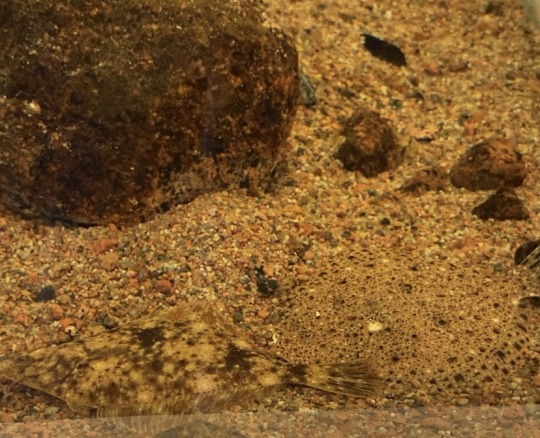

All the tanks and fish were very beautiful indeed! But the showstopper was definitely the Baltic Sea tank, which holds 680 000 liters of water. It’s the single biggest tank in all of Finland, it is seven meters deep, it gets its water from the Baltic right next to Maretarium, and it houses sturgeons, salmon, trout, perches, zanders, roaches… the list goes on.


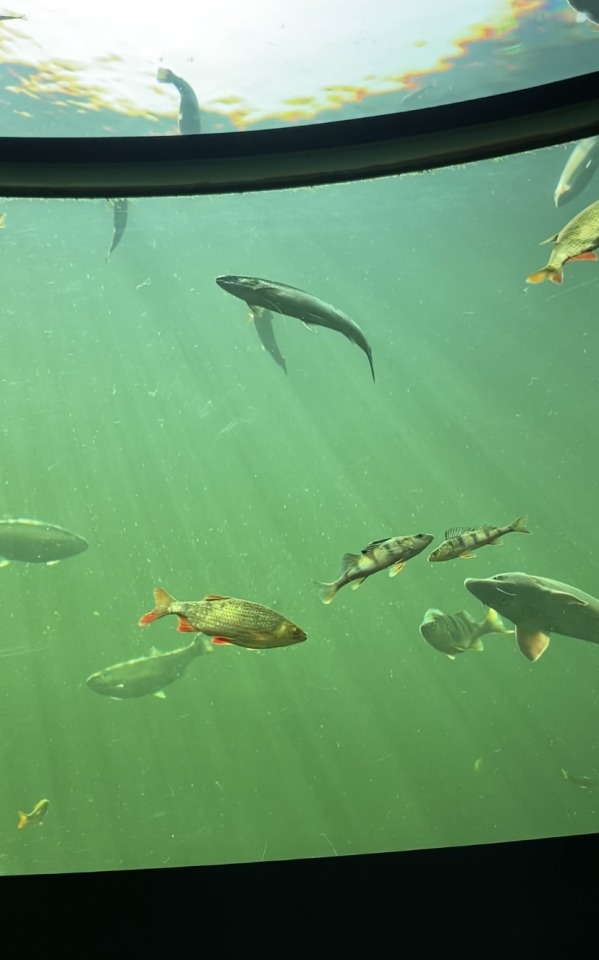
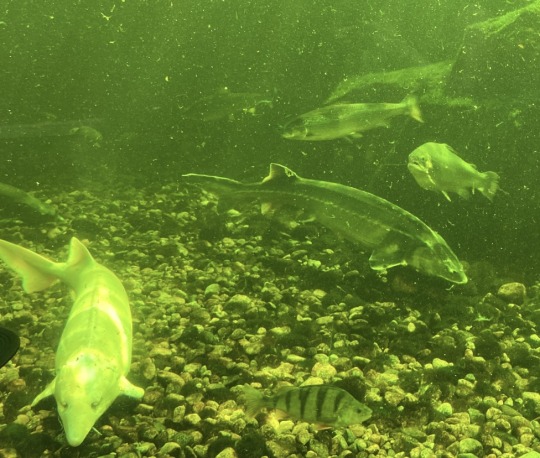
#peep the monochromatic perch! it has a mutation where it cannot produce red or green pigment which makes it appear grey. very cool!#i recommend anyone visiting or located in finland to visit this place. i could stay there for hours.#fish#aquarium#perch#european perch#smelt#european smelt#vendace#european eel#eel#eels#european carp#carp#pike#northern pike#european flounder#flounder#turbot#flatfish#common rudd#sturgeon#siberian sturgeon#russian sturgeon#atlantic salmon#salmon#rainbow trout#trout#asp#sturgeon fish
201 notes
·
View notes




